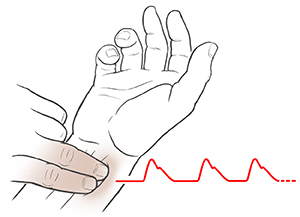Exercise and Target Heart Rate
The fitness world is full of gadgets. Some are helpful, but many are more trouble
than they are worth. Regardless of what shape you are in, one device you might find
useful is a heart rate monitor.
The key to cardiovascular fitness is getting a good, but safe, aerobic workout. Heart
rate monitors, which monitor your heart rate while you exercise, can help you do that
with ease. They range from relatively simple devices that show at a glance how many
times per minute your heart is beating, to devices that record information like how
long you were exercising at your target heart rate.
Although target heart rates might seem too complex for beginners, it's important information
to know regardless of your fitness level.
Here's a simple way to determine your maximum and target heart rates: Subtract your
age from 220 to figure out your maximum heart rate. For instance, if you are 35, your
maximum heart rate is 185 beats per minute. Your target heart rate is 50% to 85% of
that number, or 93 beats to 157 beats per minute. These numbers are based on a healthy
adult.
Feel the pulse

Now that you know what your target heart rate should be, you can calculate your heart
or pulse rate using a watch. To take your wrist, or radial, pulse, hold one hand in
front of you, palm upward. Gently place the index and middle fingers of the other
hand near the thumb-side of the wrist to feel the pulse. You should not need to press
hard to feel the pulse. It is generally better to check the radial pulse, but if for
some reason you need to check your neck, or carotid pulse, be sure to check only one
side at a time. Never press hard. Count the beats for 30 seconds, then multiply this
number by 2 to give you the beats per minute.
This method is fine for many exercisers. If you like the idea of having that information
instantly available in the middle of a workout, you might want to buy a monitor.
Heart rate monitors aren't as exact as an electrocardiogram (ECG) test, but they can
be very accurate. The most inexpensive models have 2 parts: a small transmitter mounted
on a belt that wraps around your chest, and a device like a wristwatch that displays
the numbers. There are no wires. The watch-like monitor picks up signals from the
transmitter. More modern devices have the ECG recorder embedded in a watch and watchband.
It can not only detect heart rate but also record the heart rhythm.
If you have an irregular heart rhythm, heart rate monitors are not accurate for you.
If you aren't aware of this, your results can cause panic. The sensors are not sensitive
enough to tell the difference between early heart beats and may calculate a very low
heart rate. The sensors may also pick up vibrations from a moving car or using an
electric toothbrush and calculate a high heart rate in error. Don't panic. Take your
pulse manually, as above, to see if the monitor is accurately counting your pulse.
Or check with your healthcare provider to make sure you are OK. More modern watches
are able to detect abnormal heart rhythms with more accuracy than just heart rate
monitors. However, the accuracy of these newer wearable devices is not yet known.
But if you feel extremely tired or weak, have chest pressure, feel like you can't
get enough air, or feel faint, get medical care right away by calling 911.
Getting feedback
Whether you walk, jog, run, bicycle or use stationary bikes, rowers, or ski machines,
you can see some real benefits. Feedback on your progress is important support when
you exercise. You'll find that over time you'll be able to perform longer within your
target heart rate range. You'll also notice that as you get more in shape, you can
do some tasks at a lower heart rate, or run even farther or faster at the same heart
rate.
Too often, though, beginners can push too hard. They think exercise has to hurt and
they'll work out at a pace that's impossible to keep up. A monitor helps them set
limits so they don't overdo it.
If you are a newcomer to exercise, check with your healthcare provider before starting
a fitness program. Your provider also can help you determine what target heart range
is best for you based on your health.
Run up your pulse
Your heart rate will change depending on what type of exercise you are doing. For
example, weight training can get your heart rate up to about 70% of its upper limit. It
won't stay that high for long, because lifting weights isn't a constant effort.
On the other hand, people who ride stationary bikes can generally maintain 75% of
their target heart rate for about 30 minutes of a 40-minute workout.
Runners who are in great shape also will generally maintain a high heart rate for
long periods, approaching 80% to 85% for miles at a time.